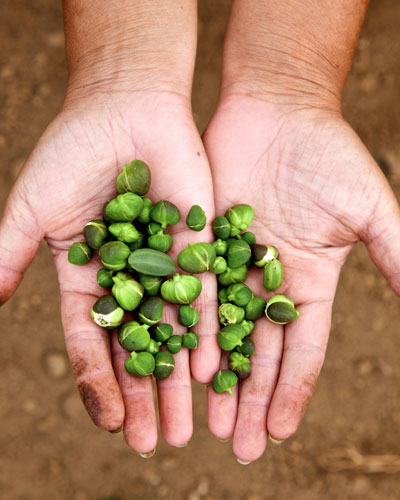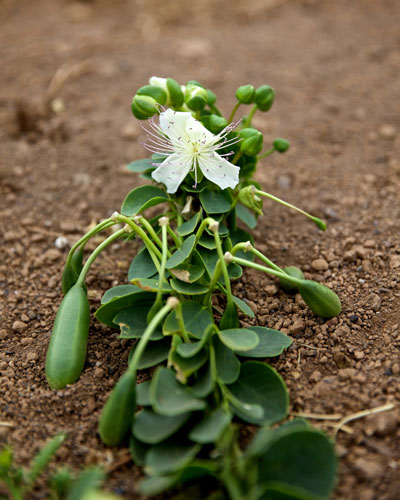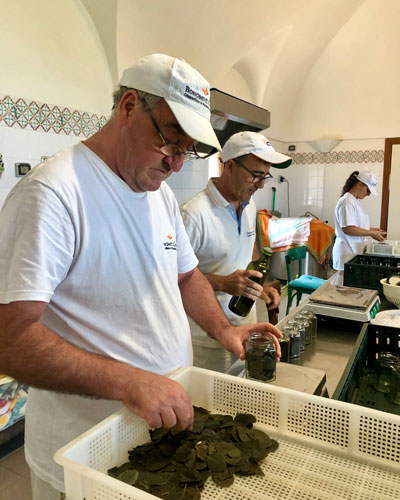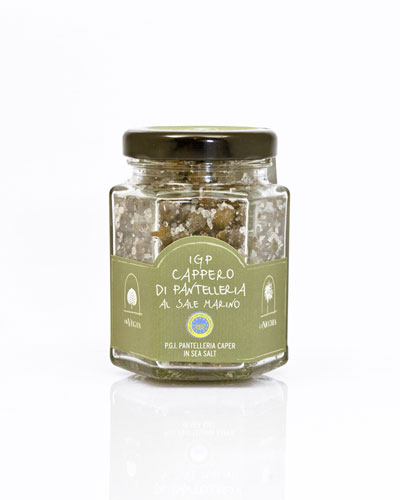
GI protection revives caper production on Pantelleria
By Michele Evangelista, Lisbon Registry and Catherine Jewell, Information and Digital Outreach Division, WIPO
The small island of Pantelleria, which lies off the southern coast of Sicily, is home to what some consider to be the world’s best capers. These intensely flavored aromatic flower buds are a gastronomic delight and a favorite garnish for many dishes and appetizers. For many years, they were the only capers in Italy to be protected as a geographical indication (GI). Gabriele Lasagni, who heads up Bonomo & Giglio, the sole company in Pantelleria to continue operating as a caper farm, processing plant and specialty food laboratory, explains how GI protection has supported caper production on the island and enabled his company to thrive, and shares his plans for the future.
Tell us about Bonomo & Giglio and its origins.

is home to what some consider to be the world's best capers.
(Photo: Courtesy of Bonomo & Giglio)
Two cousins, Antonio Bonomo and Girolamo Giglio from Pantelleria, set up the company in the aftermath of the Second World War. In September 1943, when Italy signed the Armistice of Cassibile with the Allied Forces, Antonio Bonomo, my wife’s grandfather, was serving as a soldier in northern Italy. Following the Armistice, he decided to quit the army and return home to Pantelleria. However, as it was still too dangerous to travel across Italy, he decided to stop for a time in Reggio Emilia. In fact, that’s where he met his wife and settled. In the post-war years, he began arranging shipments of traditional products, such as capers and grapes, from Pantelleria to Reggio Emilia. He saw that his relatives and friends delighted in their quality and unique flavor and that prompted him to set up a company with his cousin, Girolamo Giglio. They called the company Bonomo & Giglio. At first, they sold grapes and capers, but in the 1970s, they decided to focus exclusively on capers. After the two cousins passed away in 2004, as the husband of Antonio Bonomo’s granddaughter, I took over the family business.
Did you have any prior experience of working with capers?
No, I grew up in Emilia Romagna in the north of Italy. When I took over the company in 2004, I had no knowledge whatsoever of capers or any experience of how to run a business like this one. In fact, when I started out, I was fighting against the odds because caper production in Pantelleria was on the decline. It was my wife who introduced me to Pantelleria and its capers. I fell in love with the island’s black rocks and bright sea on my first visit. And when Antonio Bonomo died, I decided to take on my wife’s family business. I was convinced that this wonderful, unique product needed to be appreciated and given value. I’m glad to say that my determination and passion have paid off.
Tell us about your products.

(Capparis spinosa) also known as Flinders Rose.
(Photo: Courtesy of Bonomo & Giglio)
Today, the company produces and sells capers under the La Nicchia brand. We offer capers in many forms - salted, in oil, dried, and as creams. We also sell a selection of other high-quality products from the island, including honey, marmalade and wine. At first, we only produced capers that were cured in salt. That’s the form of caper that is protected as a GI, the intellectual property right that certifies that the quality of a product is linked to its geographical origin. Then, I began producing and marketing capers in other forms, for example, capers in oil and dried capers. We also began producing derivative products, such as creams and sauces, to meet the needs of a broader range of consumers and increase our sales. Although the GI status of Pantelleria’s capers has been pivotal in strengthening the company’s market position, I wanted to explore different routes and invest in new projects that would allow my company to grow and enhance its reputation, but also give value to other the products of other local producers.
How has the GI status of Pantelleria capers helped your business?
Aware of the uniqueness of the island’s capers, my company − perhaps more than any other producer on the island − has taken advantage of the GI since it was first registered. We understood that we needed to invest in the quality of our product to strengthen our position in the market and regain our competitiveness.

In the 2000s, large Italian supermarket chains launched an initiative that had important consequences for our business. They decided to create a line of regional and local premium products that reflected the excellence of Italian gastronomy. Their aim was to remind consumers of Italy’s long-standing culinary traditions and its high-quality products. As you can imagine, producers of GI-certified products were very happy about this because GI status is an irrefutable guarantee of origin, method of production and quality linked to the product’s place of origin. For the Italian supermarket chains, GI quality and certification schemes were the easiest way to offer trusted authentic products to their consumers. Their initiative opened the doors for our GI Cappero di Pantelleria to the distribution channels of Italy’s largest supermarkets making our product more widely available, at least in Italy and elsewhere in the Mediterranean.
The GI has been pivotal to the renaissance of Pantelleria capers.
Gabriele Lasagni, CEO, Bonomo & Giglio
How did the capers of Pantelleria come to acquire GI status?

preserved in sea salt to enhance their flavor.
(Photo: Courtesy of Bonomo & Giglio)
In the 1960s and 1970s, the business of capers was one of the main sources of revenue for islanders. We produced our own capers and supplemented our crop with those of other local producers and sold them on to wholesalers, suppliers and canning companies. At that time, we had not yet started building up our company brand and Pantelleria capers were not yet protected as a GI.
Then in the mid-80s, with the abolition of custom duties between Italy and other Mediterranean countries, we saw a steep decline in sales. The island’s producers just couldn’t compete with capers from Greece, North Africa and Spain. Many islanders abandoned caper production and agriculture all together and moved into the island’s booming tourism sector.
With caper production in decline, producers decided that one way to rekindle the caper business would be to register the island’s capers as a GI. We understood that we needed an official label to certify the origin, the history, the traditions and the unique qualities of the island’s capers if we were to regain our competitiveness. Thanks to the efforts of the Cooperativa Agricola Produttori Capperi, the Cappero di Pantelleria was registered as a GI in Italy in 1993 and in the European Economic Community (now the European Union) in June 1996.
The capers on Pantelleria are the best in the world. Pantelleria lies between Sicily and Africa. Its well-drained, fertile and mineral-rich volcanic soils and Mediterranean climate (low rainfall and hot summers) come together to create the unique taste of the capers we grow here.
Since the capers of Pantelleria were registered as a GI, we have remained committed to producing them to the highest standards to deliver a quality product to consumers. This commitment paid off in 2007, when, as I mentioned, large Italian supermarket chains included GI-certified Cappero di Pantelleria among their premium product lines. This was great news for us, because at that time, Bonomo & Giglio was the only player in the market that could supply them. That year, we received orders well beyond our production capacity. I had to buy-in capers from local farmers and the following year we had to increase our own production capacity. The GI has been pivotal to the renaissance of Pantelleria capers. Without the GI, we would not have been able to supply the supermarkets. Still today, demand for GI-labelled capers from Italian supermarkets is the bulk of my business and allows me to cover costs and to invest in other projects.
While GIs are often used to preserve local specialties and traditions, they are not immutable and can be adapted to new production and consumption trends. How would you like to see the I Cappero di Pantelleria GI evolve?
There are aspects of the Book of Specifications that need to be reviewed to give better value to the quality and reputation of the Cappero di Pantelleria. The last revision took place in 2010. The Book of Specifications sets out the rules of production for the GI-certified product as agreed by the producers. It is not immutable and can be updated when needed, in line with any new knowledge and techniques unveiled by producers, as long as they remain true to the origin, specificity and tradition of the GI.

In my view, we need to amend the Book of Specifications to relax the rules that producers established regarding the use of the GI. This would enable us to keep pace with new production and consumption trends, while continuing to preserve the specificities and authenticity of Pantelleria capers. At present, the GI label only allows a certain volume of capers per plant/per square meter to be commercialized. When the Cappero di Pantelleria was registered as a GI, no other capers in Italy were protected in this way and producers took inspiration from the Book of Specifications of the Passito di Pantelleria, a GI for local wines, when setting the rules for using the GI for Cappero di Pantelleria. When producing grapes, the quantity of pruning carried out on plants is inversely proportional to the quality of the grapes. In other words, the fewer grapes that are produced, the better their quality. However, capers are not grapes, and over the years, we have realized that with capers there is no real link between quantity and quality. On top of that, when producers developed the Book of Specifications for the GI Cappero di Pantelleria, they referred only to salt-cured capers. Today, it would be helpful for us to clearly mention the GI Cappero di Pantelleria as an ingredient in other preparations that are made exclusively with them, such as capers in oil and as creams. Taking advantage of the possibility that the island’s caper producers have to update the Book of Specifications would allow us to capture greater value from the GI Cappero di Pantelleria.
GI status is an irrefutable guarantee of origin, method of production and quality linked to the product’s place of origin.
Gabriele Lasagni, CEO, Bonomo & Giglio
I would also like to help establish an association of producers for the GI Cappero di Pantelleria. In Italy, such associations traditionally support producers of GI products and work to safeguard their rights by promoting and marketing the product, enforcing producers’ rights against imitation, misuse, evocation, or other acts of misappropriation and of unfair competition, and by interacting with national and international public authorities on behalf of producers. Discussions are underway among the island’s caper producers to try to set up such an association to manage our GI.
What can public authorities do to support businesses like yours?
More rigorous controls in the market against acts of imitation, misuse, evocation, and other acts of misappropriation and unfair competition would be of great help, including on processed goods. In my experience, while public authorities do in-depth controls within the value chain of the product to make sure that production complies with the Book of Specifications, national and European legislation, fewer controls take place outside of the value chain to protect the GI against free riders. If you search on the Internet, you will find lots of capers that claim falsely that they come from Pantelleria.
What are your plans for the future?
These days our capers are attracting the attention of many new market actors. For example, gourmet chefs are using them because when they use GI-certified products they add prestige and value to their menus. This growing demand for capers in different forms is another reason that it is becoming urgent for us to modify the Book of Specifications. This will allow us to meet this new market demand without losing the unique qualities and characteristics of the GI Cappero di Pantelleria. I am convinced that the strategic development of the GI will continue to benefit my business and other producers on Pantelleria.
I would also like to create partnerships with other local producers, including producers of honey and saffron to expand my offering under the La Nicchia brand. The agreement I am proposing will allow them to focus on growing and developing their businesses while I take care of buying and distributing their products. It’s a win-win arrangement. By working together in this way, we can add value to each other’s products, create jobs and generally boost the island’s economy.
About WIPO’s new virtual exhibition on origin-based product
Virtual Exhibition on Geographical Indications
Check out WIPO’s new virtual exhibition and embark on a fascinating journey around the world to discover products whose quality and reputation are due to their geographical origin.
Meet producers and artisans who, from generation to generation, have maintained and preserved their traditions and skills. Unravel individual stories as you visit exhibits from WIPO and the 39 WIPO member states and two intergovernmental organizations featured.
The exhibition will be live until December 31 and is available in six language versions (Arabic, Chinese, English, French, Russian and Spanish).
The WIPO Magazine is intended to help broaden public understanding of intellectual property and of WIPO’s work, and is not an official document of WIPO. The designations employed and the presentation of material throughout this publication do not imply the expression of any opinion whatsoever on the part of WIPO concerning the legal status of any country, territory or area or of its authorities, or concerning the delimitation of its frontiers or boundaries. This publication is not intended to reflect the views of the Member States or the WIPO Secretariat. The mention of specific companies or products of manufacturers does not imply that they are endorsed or recommended by WIPO in preference to others of a similar nature that are not mentioned.
